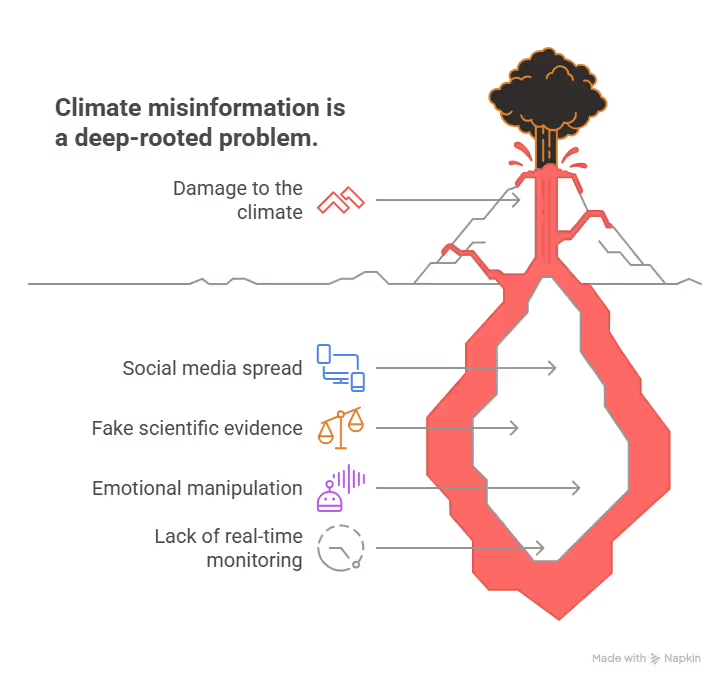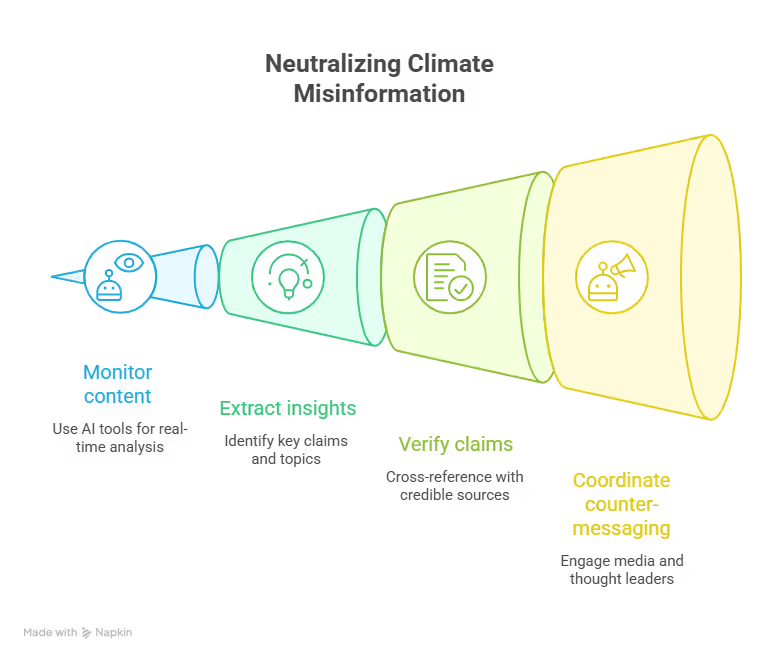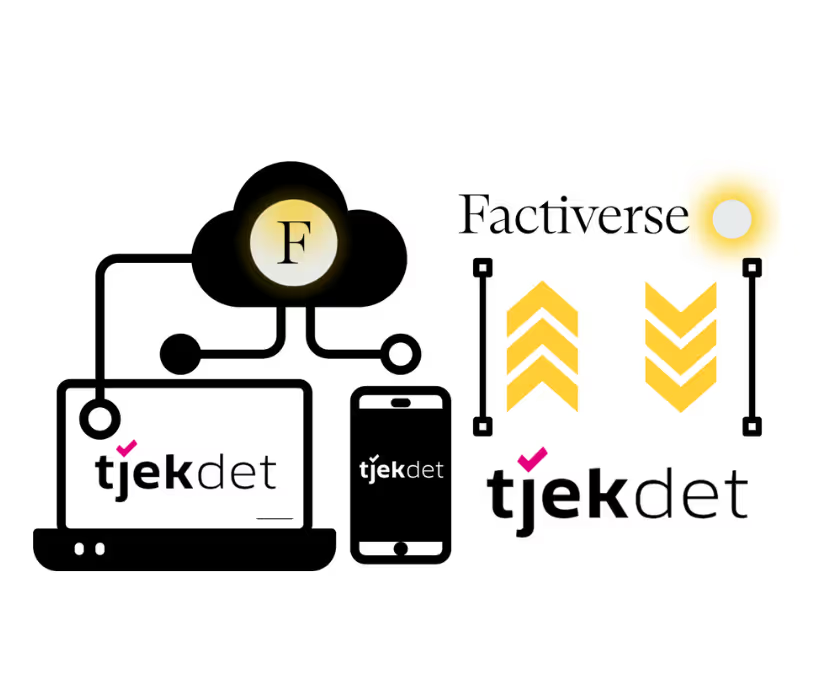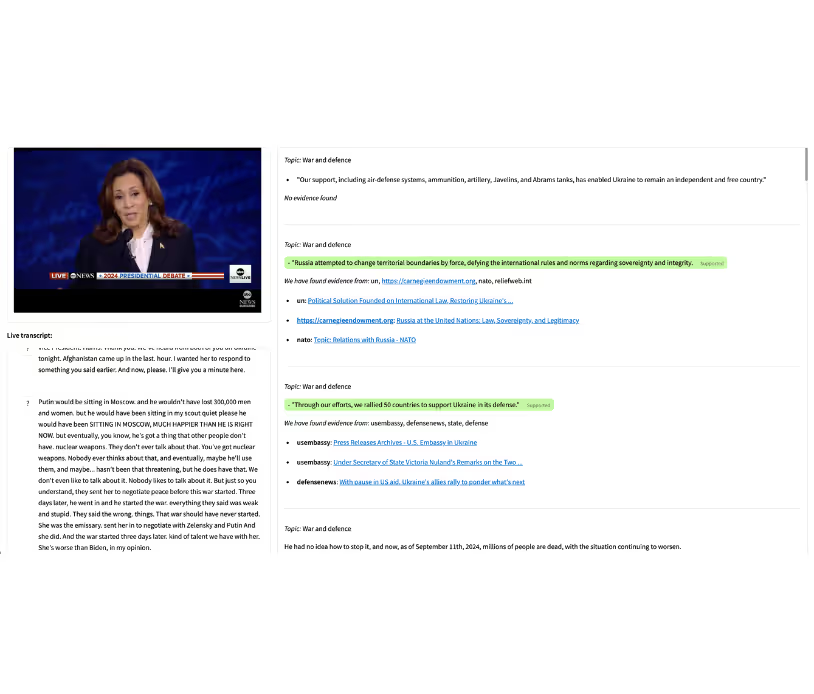
The rising threat of climate misinformation on social media
In the report "Climate Myths in Social Media" by the Bellona Foundation, found that 43% of all comments(1 million) about climate on the Facebook pages of Norwegian politicians, media, and interest groups contained climate myths. Many of which directly contradict scientific consensus (Source).
It is just one of many examples of how misinformation spreads on social media, making it harder for a real climate change. Climate misinformation thrives on speed, confusion, and emotional manipulation.
However, based on market analysis of methods against, one stands out - real-time monitoring. It disrupts that speed by flagging harmful content as it spreads, not after it spreads.

This is a tactic that fundamentally utilizes speed and ongoing awareness in digital spaces to neutralize. If you are in the public or private sector, the fastest way to deal with disinformation is by monitoring false, harmful narratives online in forums and high-trafficked websites utilizing AI powered monitoring tools.
Spikes in the amount of disinformation and misinformation usually happen before large conferences like COP or climate disasters that are currently unfolding.
Real-time monitoring can be done manually or automatically through several platforms. So let’s break down the most useful tools that utilize AI efficiently counteract climate misinformation:
1. The #ArsonEmergency Initiative
During Australia’s catastrophic 2019–2020 bushfires, a false narrative emerged on X (formerly known as Twitter) using the hashtag #ArsonEmergency, claiming that activists rather than climate change were to blame for this catastrophe (Source). This hashtag quickly went viral and caused huge amounts of misinformation to be added to an already extremely delicate and dangerous situation.
So in response to this crisis, researchers started to conduct real time monitor practices and network analysis to identify coordinated sharing patterns. From there they were able to trace the spread back to specific Twitter communities and bot accounts. With this crucial piece of information, fact-checkers and media outlets were able to create reports debunking the arson narrative and explained that the fires were a result of climate change factors. The impact of this initiative was effective and immense.
The rapid response from this monitoring limited the arson narrative hashtag’s traction. Verifiable and credible climate change information was shared at a ratio of 9:1 compared to the false claims.
The coordinated action from media coverage also significantly reduced the visibility of the false narrative on Twitter. It was able to shift the conversation back toward climate-change causes rather than fanning the flames of non-credible narratives that seek to discredit established climate science.
2. Let’s break down why it worked
It’s speed and scale was immense firstly. Through the early detection and monitoring efforts made by researchers were able to disrupt disinformation before it went too mainstream. This rapid response creates an opportunity to reduce the efforts by those with malicious intentions and limits the faults of social media sharing. This has been touted as a fundamental tactic when it comes to neutralizing misinformation online (Source).
Another reason why it was successfully neutralized was the coordination of fact-checkers and media outlets. The monitoring efforts of the researchers quickly gained visibility through their collaborations (Source). This significantly helped shape public perception around this incident and reduced the potential of climate misinformation.
Proving that coordination between various media and governmental agencies is a necessary action in similar scenarios.
3. How to use AI to power real-time monitoring
To fundamentally tackle climate misinformation and disinformation, real time monitoring is a fundamental activity that organizations need to participate in. This process can be further enhanced through the application of AI tools.
How to replicate this tactic using AI tools:
- Identify websites, channels, hashtags, or narratives likely to be manipulated (e.g., “climate scam,” “green agenda”).
- Use AI powered tools like Factiverse, others to designate ongoing monitoring and analysis practices on these pieces of content in real time. Extract key insights like claims, topics and other credible sources.
- Cross-reference flagged claims or narratives with verified climate science sources or domain experts.
- Coordinate with media outlets and other thought leaders to create counter-messaging. This can be shared through social media where the claims originated from or shared on a large platform that has an audience that can dwarf the initial harmful narrative.

4. The key to neutralizing climate misinformation is coordination and real-time monitoring
Neutralizing climate misinformation in the digital age requires more than just individual vigilance; it demands collective, coordinated action.
Real-time monitoring, especially when powered by AI, offers a crucial first line of defense by detecting harmful narratives before they go viral. But detection alone is not enough.
As the #ArsonEmergency case showed, the real power lies in how quickly and cohesive researchers, fact-checkers, media outlets, and even governmental agencies can respond together.
This collaboration amplifies credible information, reduces the reach of disinformation, and shifts public discourse back toward facts. By combining speed, technology, and strategic partnerships, organizations can create a unified front that significantly blunts the impact of climate misinformation making coordination not just a tactic, but the backbone of any effective response.










































































.avif)















